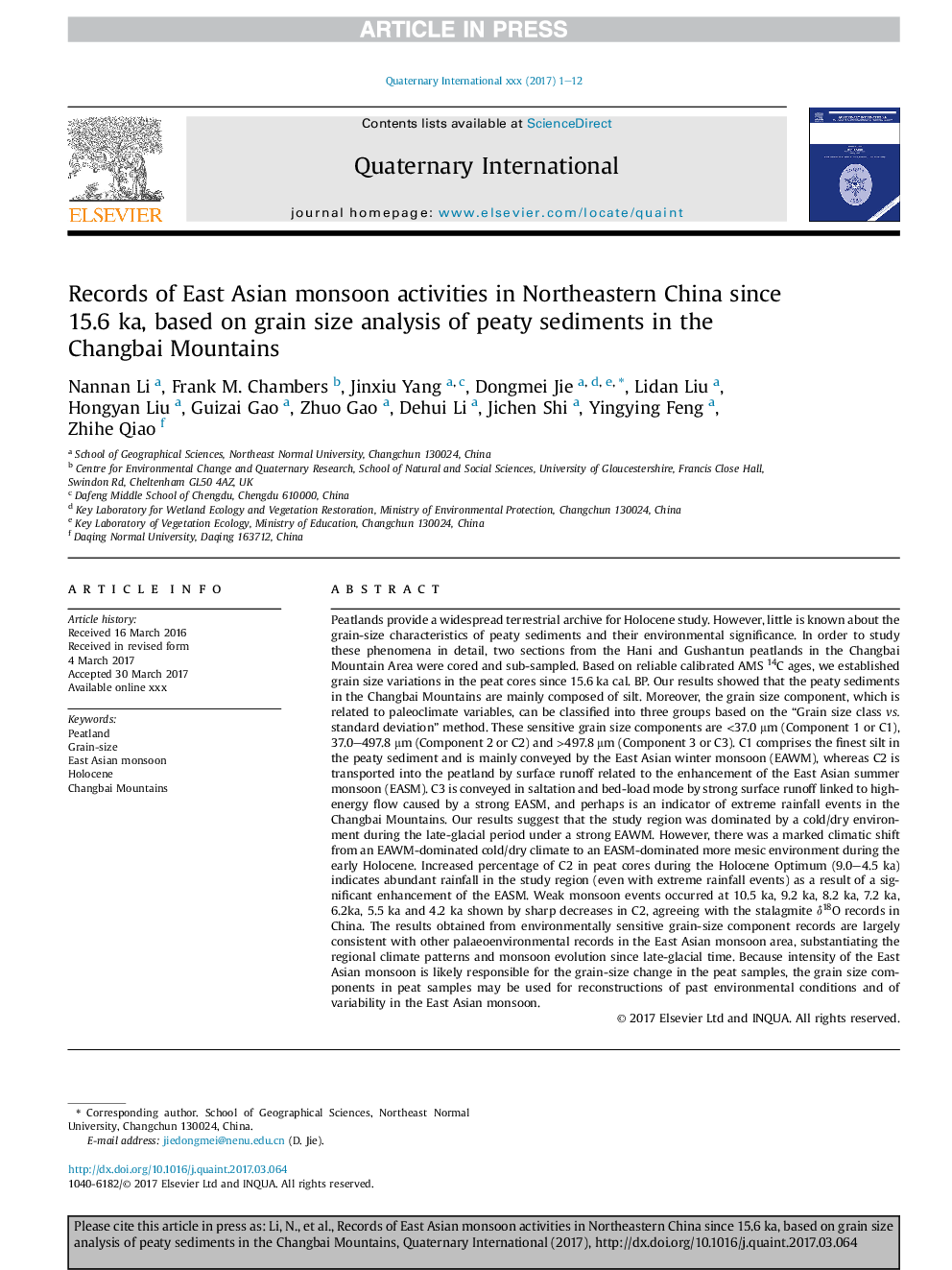| کد مقاله | کد نشریه | سال انتشار | مقاله انگلیسی | نسخه تمام متن |
|---|---|---|---|---|
| 5113118 | 1484076 | 2017 | 12 صفحه PDF | دانلود رایگان |
عنوان انگلیسی مقاله ISI
Records of East Asian monsoon activities in Northeastern China since 15.6 ka, based on grain size analysis of peaty sediments in the Changbai Mountains
ترجمه فارسی عنوان
سوابق فعالیت های موسمی شرق آسیا در شمال شرقی چین از 15.6 کیلو ولت بر اساس تجزیه و تحلیل اندازه دانه های رسوبی در کوه های چانگبی
دانلود مقاله + سفارش ترجمه
دانلود مقاله ISI انگلیسی
رایگان برای ایرانیان
کلمات کلیدی
زمین لرزه، اندازه دانه، موزون شرق آسیا، هولوسن، کوه های چانگبی،
موضوعات مرتبط
مهندسی و علوم پایه
علوم زمین و سیارات
زمین شناسی
چکیده انگلیسی
Peatlands provide a widespread terrestrial archive for Holocene study. However, little is known about the grain-size characteristics of peaty sediments and their environmental significance. In order to study these phenomena in detail, two sections from the Hani and Gushantun peatlands in the Changbai Mountain Area were cored and sub-sampled. Based on reliable calibrated AMS 14C ages, we established grain size variations in the peat cores since 15.6 ka cal. BP. Our results showed that the peaty sediments in the Changbai Mountains are mainly composed of silt. Moreover, the grain size component, which is related to paleoclimate variables, can be classified into three groups based on the “Grain size class vs. standard deviation” method. These sensitive grain size components are <37.0 μm (Component 1 or C1), 37.0-497.8 μm (Component 2 or C2) and >497.8 μm (Component 3 or C3). C1 comprises the finest silt in the peaty sediment and is mainly conveyed by the East Asian winter monsoon (EAWM), whereas C2 is transported into the peatland by surface runoff related to the enhancement of the East Asian summer monsoon (EASM). C3 is conveyed in saltation and bed-load mode by strong surface runoff linked to high-energy flow caused by a strong EASM, and perhaps is an indicator of extreme rainfall events in the Changbai Mountains. Our results suggest that the study region was dominated by a cold/dry environment during the late-glacial period under a strong EAWM. However, there was a marked climatic shift from an EAWM-dominated cold/dry climate to an EASM-dominated more mesic environment during the early Holocene. Increased percentage of C2 in peat cores during the Holocene Optimum (9.0-4.5 ka) indicates abundant rainfall in the study region (even with extreme rainfall events) as a result of a significant enhancement of the EASM. Weak monsoon events occurred at 10.5 ka, 9.2 ka, 8.2 ka, 7.2 ka, 6.2ka, 5.5 ka and 4.2 ka shown by sharp decreases in C2, agreeing with the stalagmite δ18O records in China. The results obtained from environmentally sensitive grain-size component records are largely consistent with other palaeoenvironmental records in the East Asian monsoon area, substantiating the regional climate patterns and monsoon evolution since late-glacial time. Because intensity of the East Asian monsoon is likely responsible for the grain-size change in the peat samples, the grain size components in peat samples may be used for reconstructions of past environmental conditions and of variability in the East Asian monsoon.
ناشر
Database: Elsevier - ScienceDirect (ساینس دایرکت)
Journal: Quaternary International - Volume 447, 15 August 2017, Pages 158-169
Journal: Quaternary International - Volume 447, 15 August 2017, Pages 158-169
نویسندگان
Nannan Li, Frank M. Chambers, Jinxiu Yang, Dongmei Jie, Lidan Liu, Hongyan Liu, Guizai Gao, Zhuo Gao, Dehui Li, Jichen Shi, Yingying Feng, Zhihe Qiao,
